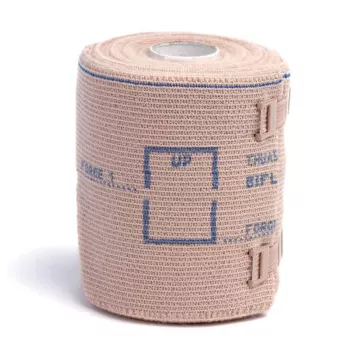When your legs become heavy, painful or swollen, don't wait for the problem to get worse. In many cases, a simple compression bandage can make all the difference. Easy to use, space-saving and formidably effective, they promote venous return, reduce edema and relieve circulatory pain. Looking for a simple solution to improve your day-to-day comfort? This category is for you.
More details
Used for both prevention and treatment, compression bands are a recognized medical device, available in hospitals and pharmacies alike. And today, you can order them online, straight from your home. Ready to give your blood circulation a boost?
The history of compression bandages dates back to antiquity, when the beneficial effects of localized compression on the legs were already understood. But it was not until the 20th century that modern compression therapy took shape, with pressure-controlled elastic bands designed to treat venous pathologies such as varicose veins, deep vein thrombosis and chronic edema.
Today, specialist brands (Urgo, Lohmann & Rauscher, Thuasne, Hartmann...) are developing ever more technical bandages: controlled elasticity, degressive pressure, soft, breathable textiles- everything is designed to offer optimal support without discomfort. These bands are used to treat venous disorders as well as to accelerate the resorption of a hematoma, stabilize a sprain or hold a bandage in place.
Compression bandages embody the very best of modern medicine: simplicity, effectiveness and accessibility.
There's no such thing as a single compression bandage, but rather a whole range of solutions to suit every need. Here are the main families you need to know about to make the right choice:
Each band is available in a range of lengths, widths and pressure levels (light, medium, heavy), with or without fastening clips. Some are washable and reusable, while others are intended for single use only.
Using a compression band is not something you can improvise. To make sure it's really effective (and comfortable!), follow these simple tips:
Above all, if you feel any discomfort, unusual pain or numbness, remove the bandage immediately and seek professional advice.
At the chemist's, we often see heavy legs lying around... instead of being relieved. Too many patients wait until the swelling is visible, or the pain becomes disabling, before reacting. Yet a well-chosen and well-applied bandage can prevent these situations from the very first signs.
Here are a few practical recommendations:
Your pharmacist can advise you on the choice of model, application technique and level of compression required according to your morphology and needs.
A compression bandage is an excellent start. But for lasting comfort, nothing beats a holistic, natural approach. Here are a few simple tips to incorporate into your daily routine:
With these little gestures, your compression bandage won't be doing the work alone. You act in synergy to restore light, toned and dynamic legs.
In short, the compression band is a simple yet powerful tool for preventing, treating and relieving many venous and muscular disorders. Easy to use, affordable and effective, they are suitable for all profiles - young, old, sporty, bedridden... Don't wait for your legs to speak too loudly to listen to them. Give them the targeted support, lightness and lasting protection they deserve.